David A. Balfour Park, midtown Toronto’s largest public green space, has finally re-opened after being closed for infrastructure repairs and upgrades since April 2018, shutting off residents from 20 hectares of walking trails, a playground, community garden, and sports field during the height of the Covid pandemic. The park was slated to re-open in April 2021, but as of November 2022, work continues on fixing construction deficiencies. The official opening is planned for Spring 2023.
“It was horrible that it was closed for long,” said Fabienne Thuet, a resident of the Yonge-St. Clair area for 27 years. “This is our neighbourhood park. I walk here almost every day.”
“We call this our Central Park,” said Jaffa Charney, who has lived for 25 years in a condo facing the park. “I walk in the park every day, and always meet a neighbour to chat with. It’s a very social place.”
David A. Balfour Park — named after a Toronto politician (1939-1955) perhaps best known for his unsuccessful campaigns to ban “salacious books,” including The Grapes of Wrath, Double Indemnity, and The Decameron — has long been cherished by midtown residents. Many of the trees and benches in the park were donated in memory of loved ones. The community raised $80,000 for a garden in 2008, which is still tended by volunteers.
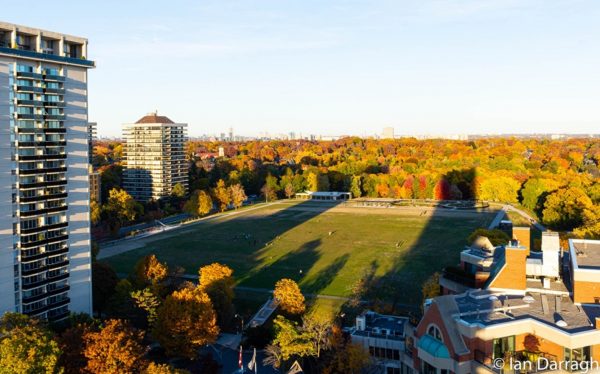
David A. Balfour Park is surrounded on the west and north sides by high-rise condos and apartment buildings. The park is an oasis of green amid a growing forest of condo towers – more than 15 more condos are in the planning stages in midtown Toronto. This will put even more pressure on David A. Balfour Park since many condos seem to have as many canine residents as humans, and these dogs need somewhere to run and do their business.
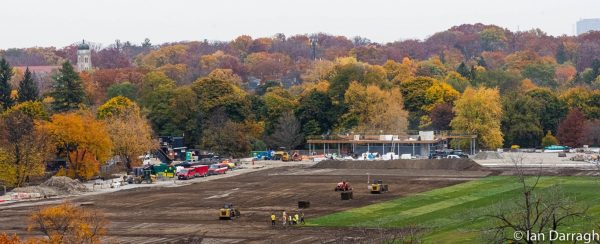
Much of the park sits atop Rosehill Reservoir, Toronto’s oldest and largest in-ground drinking water basin. Constructed in 1873-74, it stores 270 million litres and is the source of drinking water for 675,000 Torontonians. The site of the reservoir was chosen because it sits on a flat terrace above the escarpment that was the shoreline of glacial Lake Iroquois – an enlargement of what is now Lake Ontario that existed until 13,000 years ago, at a time when most of what is now downtown Toronto was underwater. This means that water from the reservoir flows via gravity to households and businesses to the south. The reservoir was last upgraded and covered 1966. The rehabilitation that began in 2018 was a complicated infrastructure project: trees and shrubs on the top and sides of the reservoir had to be removed and all the soil and sod had to be trucked away and stored —nearly 32,000 cubic metres, more than 2,000 dump-truck loads. Like an iceberg, most of the Rosehill Reservoir rehab project was out of sight. The bulk of the contract ($30.6 million) was allocated to upgrading pumps, valves, pipes, and electrical systems inside the reservoir and connecting to the city water system; and to repairing, cleaning and waterproofing inside the reservoir and its roof. What we now see above ground, the park amenities and upgrades, cost $4.8 million.
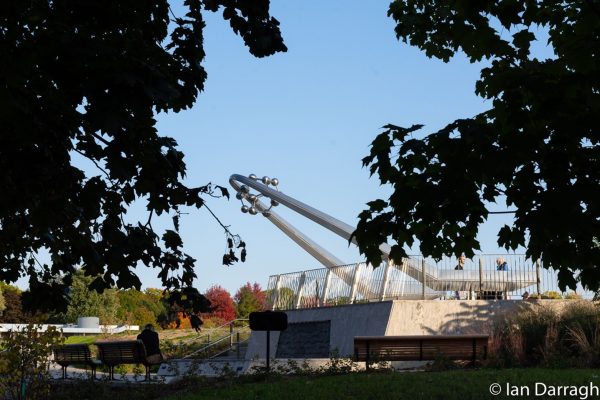
The peeling open of the reservoir created a once-in-a-lifetime opportunity to re-imagine David A. Balfour Park. Toronto Parks literally had a clean slate of concrete to work with. My apartment is half a block from the park, and from my kitchen window I’ve had a pigeon’s eye view of construction over the past four years. I attended public consultations before the hoarding went up around the park in April 2018, so can report on citizen input into the park design, the new park’s hidden gems, and lost opportunities to create a more people-friendly green oasis in mid-Toronto.
Since it unofficially opened in August 2022, I’ve spoken to many neighbours about what they like and don’t like about the redesigned park. One of the most striking additions is two huge cast-iron water valves mounted at the Avoca Avenue and Summerhill entrances to the park. These are striking symbols of Rosehill Reservoir’s role in supplying clean drinking water. The 2.5-metre valves were replaced by Bennett Mechanical Installations Ltd. when the interior of the reservoir was rehabilitated. (Bennett, the principal contractor for the reservoir rehabilitation, did not respond to a request for an interview.) I’m often asked what these “industrial sculptures” of cast iron are. Unfortunately, as of November 2022 there were no plaques identifying them, though amateur detectives can see, stamped in metal on the side of each valve, the date and place of manufacture: Lasalle, Quebec, 1964.
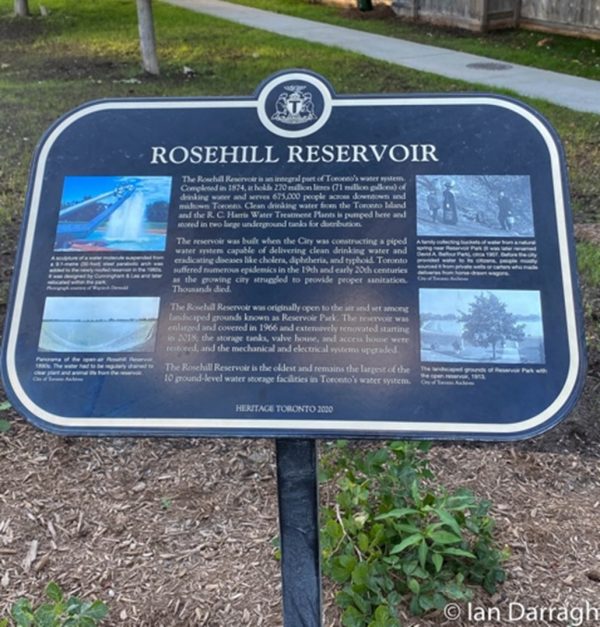
Many folks I spoke to in the park were under the impression that the water in Rosehill Reservoir comes from Yellow Creek in the nearby ravine, or from the Oak Ridges Moraine. In fact, the water is pumped from the city’s treatment plants on Lake Ontario. The drinking water in Rosehill Reservoir is an emergency back-up if one of the treatment plants breaks down, or there is a break in the intake pipe in Lake Ontario.
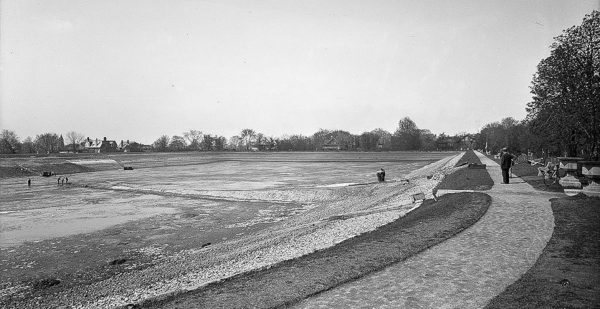
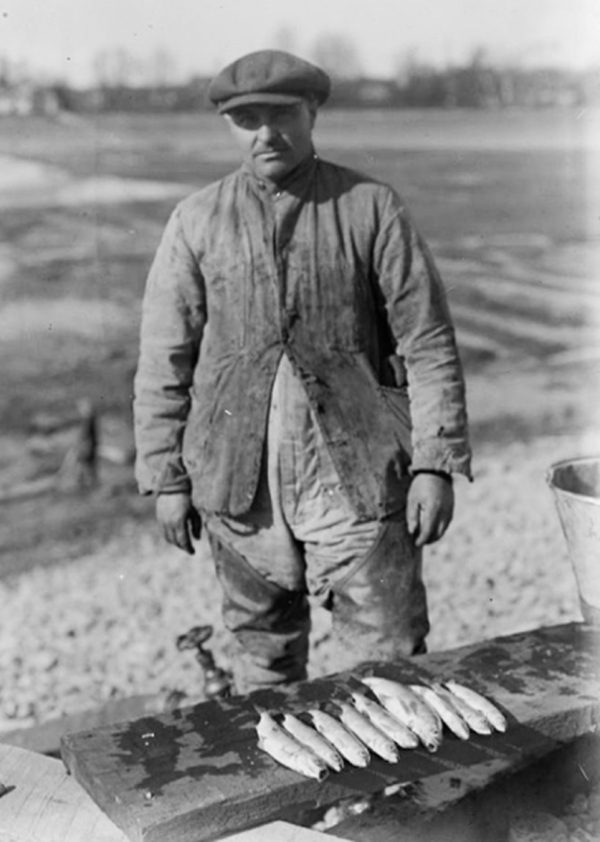
The Heritage Toronto plaques have photos of when David A. Balfour Park included gardens, paths, and ponds in the Vale of Avoca Ravine on the park’s eastern boundary. The park includes Yellow Creek and the ravine it flows through, bounded to the east by Mount Pleasant Road. Two trails still connect David A. Balfour Park to the Vale of Avoca Ravine. But despite the city’s ravine strategy, there is no signage at park entrances showing where the ravine access trails are. And only one trail has a weathered sign labelled “Nature Trail,” with no indication that you can follow the trail through the ravines either south to the Brick Works or north to Mount Pleasant Cemetery. The ravine access trails have not been maintained, and as of November 2022, there was still the remains of a construction fence used to block the trail when the park was closed.
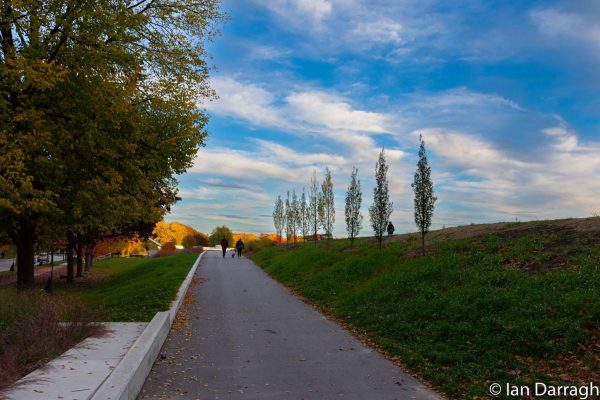
The path around the top of the reservoir used to be a dirt track principally used by joggers. Now it has been paved, enabling folks using wheelchairs or walkers to make a tour around the top of the reservoir. Deborah Briggs, president of the Summerhill Residents Association, identified this new accessible path and the improved lighting along the lower path around the reservoir as her top two improvements to the park’s amenities. The lower path is gently curved in places, and most of the walkway is shaded by mature trees, making it a pleasant walk even in the heat of mid-day during summer. Additional picnic tables and benches have been added throughout the park, including benches under trellises on the east and west sides of the top of the reservoir.
The trellises were supposed to provide shade, but they have proven to be as useless as screen doors in a submarine. The slats in the roofs of the trellises are vertical, and the roofs are narrow. I had a picnic under the eastern trellis in November, and even with the slanting late Fall sun, the trellis provided no shade. Many folks complained that the trellises do not provide any shelter from rain either. So if you get caught in a downpour, the only place to find refuge are the two benches under an overhang outside the new washroom building.
The most contentious issue facing David A. Balfour Park divides the neighbourhood into three distinct camps. All entrances to the park are posted with signs citing a bylaw that dogs must be leashed. Gleefully ignoring this are folks (and professional dog walkers) who bring their four-footed companions to run loose on top of the reservoir, starting before dawn. There is a smaller contingent of dog owners who keep their pooches on leashes, and then there are the folks who are dog-less. One long-time community volunteer pleaded with me not to quote her views about dogs in the park — “I’ll have everyone mad at me!”
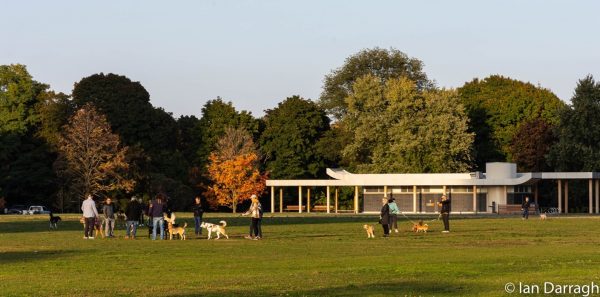
Some of the dogs running free on top of the reservoir get overly excited and out of control. I saw a large standard poodle jump up and snatch a slice of pizza out of the hand of a fellow enjoying his lunch on one of the new park benches. I’ve had a Bichon Frisé help herself to the picnic I was enjoying on a sunny, warm November afternoon. I’ve seen dogs (off-leash) enter the washroom with their masters and slip under the fence surrounding the community garden, which has several “No dogs allowed” signs posted. Since the park opened unofficially in August 2022, the City of Toronto says bylaw officers have patrolled the park once, but no tickets have been issued for violating the no dogs off-leash bylaw. So it’s a canine free-for-all on top of the reservoir every day.
“There should have been an off-leash dog area included in the park design,” Jaffa Charney told me as we sat on a bench watching dogs chasing each other back and forth on top of the reservoir. “A lot of the people who use the park are elderly, and I’m worried about dogs off-leash charging them.”
During public consultations, many folks suggested adding an off-leash dog enclosure, but this suggestion was not included in the final plan.
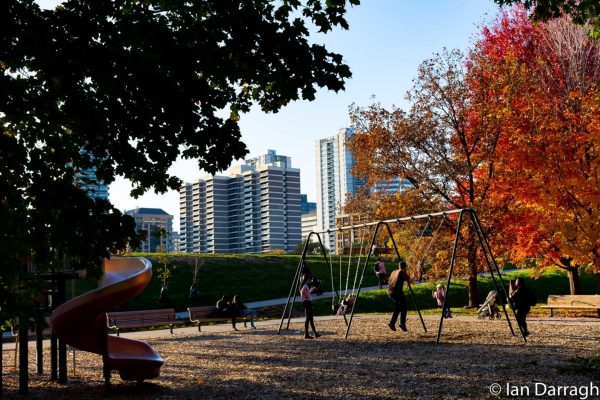
Another suggestion made during the community consultation was to have a splash pad play area for children. The 1966 park design included a fountain in the centre of the reservoir roof, and pools and a stream led to a waterfall on Rosehill Avenue. There was also a splash pad for kids near the community garden. Given that David A. Balfour Park sits atop millions of litres of water, many citizens argued that a water play feature for kids would symbolically reflect the nature of the waterworks below. But city engineers determined that a splash pad could cause leaks in the membrane covering the reservoir roof, and nixed suggestions to locate a water play area elsewhere. Instead, the city decided to install a small playground in a flat area on the eastern edge of the park near the ravine escarpment, replacing a similar playground situated there before the renovation.
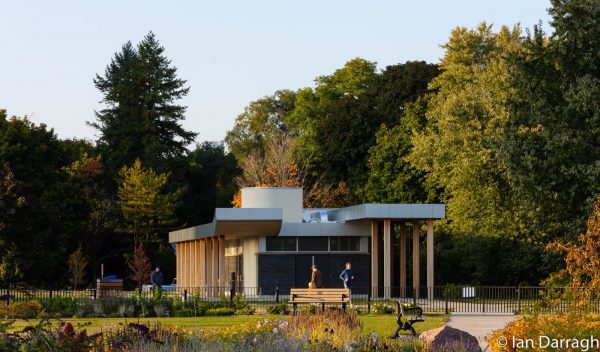
The City of Toronto webpage on the Rosehill Reservoir Rehab project stated that the new washroom at David A. Balfour Park was an all-season facility. But when I asked the city to confirm this, I was informed this was an error; the new washroom will only be open from May to October. The city could not confirm if any porta-potties will be provided from November to April. Given motions at Toronto City Council requesting that more municipal washrooms be operational in winter, it was a major missed opportunity not to design the new washroom at David A. Balfour Park to be operational year-round.
The initial re-design for the top of Rosehill Reservoir called for earth berms to be installed. This proposal was rejected during community consultations when residents pointed out that the top of the reservoir is used for soccer and ultimate Frisbee, and a private school uses the field for physical education classes. City engineers did not want soccer goal posts installed on top of the reservoir, since they feared that the footings could damage the waterproofing. So after the top of the reservoir was re-waterproofed, new sod was laid over the entire top of the reservoir in late October and November of 2020. Although the park was closed for 21 months after the sod was laid down, as of November 2022 much of the turf is in poor shape.
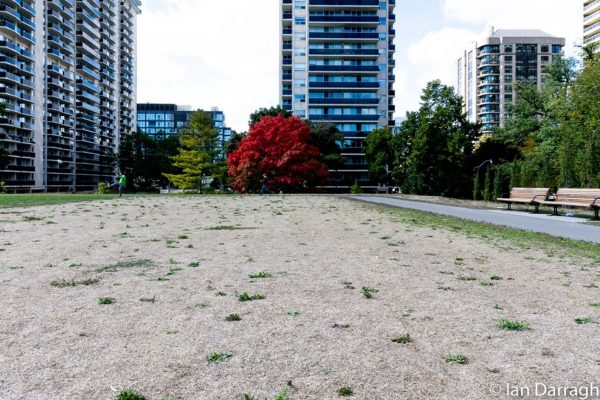
The turf on top of the reservoir is now in much worse shape than before the Rosehill Rehab project started in 2018. I asked the city whether the contractor would be responsible fixing this deficiency, and was informed that this issue will be evaluated in Spring 2023.
While residents are delighted to have their cherished David A. Balfour Park open again, there are many lessons to be learned from this project. Given that the re-opening of the park was 15 months late, and work is still on-going, our governments and agencies need to do a better job of delivering infrastructure projects on time (see the Eglinton Crosstown Light Rail project). With David A. Balfour Park, it was a lost opportunity not to winterize the new washrooms. And to support the Toronto’s ravine strategy, the trails into the Vale of Avoca Ravine need to be upgraded and signage installed. This oversight could easily be fixed before the official re-opening of the park in Spring 2023.
Ian Darragh was editor-in-chief of Canadian Geographic magazine and has published features in National Geographic magazine. He led ravine walks for Heritage Toronto and has volunteered to clean-up and remove invasive species from Toronto’s ravines.

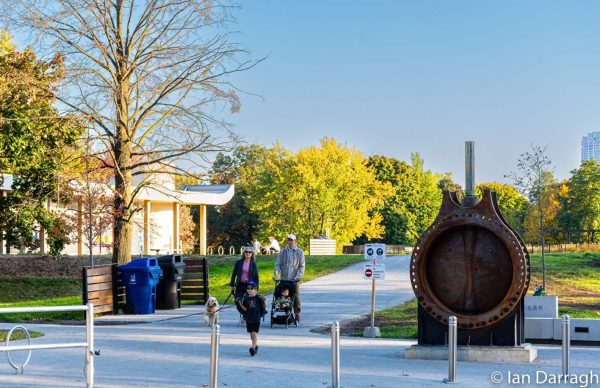



4 comments
Great piece. Having recently moved to the neighborhood, I never experienced the park pre-renovation – but agree with the mixed reviews here. Some good bits (the community garden is a gem), lots of middling, and some glaring missed opportunities.
Another personal gripe is the muddy tire tracks and churned up areas of the grass where City parks staff choose to drive their pickups. Probably doesn’t help with the (already) fading feel of the main turfed area.
Excellent & balanced assessment of the reservoir renovations. Unacceptably long overdue completion date was extremely disappointing, as is the fact the washrooms are not accessible half the year. There is a water feature in the park? News to me – I have not spotted it yet. All of the off-leash dogs are a HUGE problem – the entire park is an off-leash dog park. The children’s fenced-in play area is minuscule in comparison. I love the lower level lighting around the perimeter of the park. Notwithstanding a few mis-steps in the design, and the fact the park is still not finished, it is wonderful to once again have access to this mid-town gem.
Hi Felix, Good point — I’ve also been noticing and photographing the tire tracks on the new sod at the Avoca entrance to David A. Balfour Park. There are collapsible bollards at the entrance designed to provide access to the park for service vehicles. I’ve sent an email to 311 Toronto requesting that park staff and contractors start using the concrete ramps designed for service access to the park. Many thanks for taking the time to write your comments. I’ve posted photos of the tire tracks on the new sod on Instagram and Twitter.
Two years late and $5 Million dollars for above ground improvements. They should have paid for better turf and grass seed ! But the benches under the trellises are great to protect people from rain and sun. Oh wait they don’t ! Well thought out design…
NO wading pool for kids. NO thinking on the dogs and off leash area. NO water at the fountains for the last 6 weeks. NO real picnic area with tables or god forbid a few BBCues in the summer to use. NO parking – A few people still own cars and may want to use the park. NO pickleball courts that require little space. There is a paved path so you can put down a paved surface. NO soccer goals. NO lights at the top path – just the bottom.
I could continue…
BUT they did save the strange silver ball chandelier. Must have been a heritage piece.
Very mediocre results and 2 years late is embarrassing.